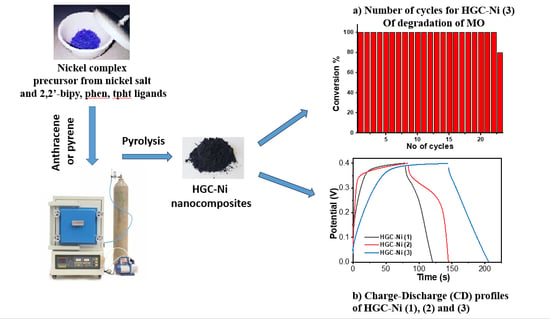Catalytic and Capacitive Properties of Hierarchical Carbon–Nickel Nanocomposites
Abstract
:1. Introduction
2. Result and Discussion
2.1. Preparation of Hierarchical Graphitic Carbon–Nickel Nanocomposites
2.2. Characterization of Nanomaterials
2.2.1. Scanning Electron Microscopy (SEM)
2.2.2. SEM-EDAX and Mapping
2.2.3. Powder X-ray Diffraction Analysis of the Nickel Nanocomposites
2.3. Catalytic Study
2.3.1. Determination of Catalytic Activity of HGC-Ni Nano-Catalyst for Hydrogenation of PNP and MO
2.3.2. Batch Catalytic Experiment: Chemical, Photochemical, and Regeneration
2.3.3. Mechanism of Hydrogenation of PNP and MO by HGC-Ni Catalysts
2.4. Electrochemical Properties of HGC-Ni Catalysts
3. Experimental Section
3.1. Equipment
3.2. Preparation of Metal Complexes
3.2.1. Ni(2,2′-bipyridine)Cl2.H2O
3.2.2. [Ni(tpht)(2,2′-bipy)].4H2O
3.2.3. [Ni(phen)2(H2O)2]SO4.5.6H2O
3.3. Preparation of Hierarchically Graphitic Carbon Containing Nickel Nanoparticles HGC-Ni
3.3.1. Preparation HGC-Ni (1)
3.3.2. Preparation of HGC-Ni (2)
3.3.3. Preparation of HGC-Ni (3)
3.4. Catalysis Experiment
3.4.1. Catalytic Reduction of p-Nitrophenol (P-NP)
3.4.2. Catalytic Reduction of Methyl Orange (MO)
3.4.3. Electrochemical Measurements and Calculation
4. Conclusions
Supplementary Materials
Author Contributions
Funding
Data Availability Statement
Conflicts of Interest
References
- Karakas, K.; Celebioglu, A.; Celebi, M.; Uyar, T.; Zahmakiran, M. Nickel nanoparticles decorated on electrospun polycaprolactone/chitosan nanofibers as flexible, highly active and reusable nanocatalyst in the reduction of nitrophenols under mild conditions. Appl. Catal. B Environ. 2017, 203, 549–562. [Google Scholar] [CrossRef]
- Velusamy, S.; Roy, A.; Mariam, E.; Krishnamurthy, S.; Sundaram, S.; Mallick, T.K. Effectual visible light photocatalytic reduction of para-nitro phenol using reduced graphene oxide and ZnO composite. Sci. Rep. 2023, 13, 9521. [Google Scholar] [CrossRef]
- Emmanuel, S.S.; Adesibikan, A.A.; Opatola, E.A.; Olawoyin, C.O. A pragmatic review on photocatalytic degradation of methyl orange dye pollutant using greenly biofunctionalized nanometallic materials: A focus on aquatic body. Appl. Organomet. Chem. 2023, 37, e7108. [Google Scholar] [CrossRef]
- Kishor, R.; Purchase, D.; Dattatraya, G.; Ganesh, R.; Fernando, L.; Ferreira, R.; Bilal, M.; Chandra, R.; Naresh, R. Ecotoxicological and health concerns of persistent coloring pollutants of textile industry wastewater and treatment approaches for environmental safety. J. Environ. Chem. Eng. 2021, 9, 105012. [Google Scholar] [CrossRef]
- Khan, I.; Saeed, K.; Ali, N.; Khan, I.; Zhang, B.; Sadiq, M. Heterogeneous photodegradation of industrial dyes: An insight to different mechanisms and rate affecting parameters. J. Environ. Chem. Eng. 2020, 8, 104364. [Google Scholar] [CrossRef]
- Sam, S.P.; Tan, H.T.; Sudesh, K.; Adnan, R.; Ting, A.S.Y.; Ng, S.L. Phenol and p-nitrophenol biodegradations by acclimated activated sludge: Influence of operational conditions on biodegradation kinetics and responding microbial communities. J. Environ. Chem. Eng. 2021, 9, 105420. [Google Scholar] [CrossRef]
- Nekoeinia, M.; Yousefinejad, S.; Hasanpour, F.; Dezaki, M.Y. Highly efficient catalytic degradation of p-nitrophenol by Mn3O4.CuO nanocomposite as a heterogeneous fenton-like catalyst. J. Exp. Nanosci. 2020, 15, 322–336. [Google Scholar] [CrossRef]
- Wang, X.; Zhao, J.; Song, C.; Shi, X.; Du, H. An Eco-Friendly Iron Cathode Electro-Fenton System Coupled with a pH-Regulation Electrolysis Cell for p-Nitrophenol Degradation. Front. Chem. 2022, 9, 837761. [Google Scholar] [CrossRef] [PubMed]
- Jiang, P.; Zhou, J.; Zhang, A.; Zhong, Y. Electrochemical degradation of p-nitrophenol with different processes. J. Environ. Sci. 2010, 22, 500–506. [Google Scholar] [CrossRef]
- Wu, Z.; Yuan, X.; Zhong, H.; Wang, H.; Zeng, G.; Chen, X.; Wang, H.; Zhang, L.; Shao, J. Enhanced adsorptive removal of p-nitrophenol from water by aluminum metal-organic framework/reduced graphene oxide composite. Sci. Rep. 2016, 6, 25638. [Google Scholar] [CrossRef]
- Kumar, S.; Singh, S.; Srivastava, V.C. Electro-oxidation of nitrophenol by ruthenium oxide coated titanium electrode: Parametric, kinetic and mechanistic study. Chem. Eng. J. 2015, 263, 135. [Google Scholar] [CrossRef]
- Zhao, P.; Feng, X.; Huang, D.; Yang, G.; Astruc, D. Basic concepts and recent advances in nitrophenol reduction by gold- and other transition metal nanoparticles. Coord. Chem. Rev. 2015, 287, 114. [Google Scholar] [CrossRef]
- Khan, A.U.; Zahoor, M.; Rehman, M.U.; Shah, A.B.; Zekker, I.; Khan, F.A.; Ullah, R.; Albdrani, G.M.; Bayram, R.; Mohamed, H.R.H. Biological Mineralization of Methyl Orange by Pseudomonas aeruginosa. J. Water 2022, 14, 1551. [Google Scholar] [CrossRef]
- Ahmed, H.M.; Fawzy, M.E.; Nassar, H.F. Effective Chemical Coagulation Treatment Process for Cationic and Anionic Dyes Degradation, Egypt. J. Chem. 2022, 65, 301–310. [Google Scholar] [CrossRef]
- He, W.; Liu, Y.; Ye, J.; Wang, G. Electrochemical degradation of azo dye methyl orange by anodic oxidation on Ti4O7 electrodes. J. Mater. Sci. Mater. Electron. 2018, 29, 14065–14072. [Google Scholar] [CrossRef]
- Tran, V.A.; Kadam, A.N.; Lee, S.W. Adsorption-assisted photocatalytic degradation of methyl orange dye by zeolite-imidazole-framework-derived nanoparticles. J. Alloys Compd. 2020, 835, 155414. [Google Scholar] [CrossRef]
- Rajput, N.L.; Mughal, M.A.; Balouch, A.; Khan, K.M.; Tunio, S.A.; Kanwal; Sohu, S. Effective photocatalytic methylene orange dye degradation ability in coloured textile contaminated water by highly efficient catalyst Schiff-based resin-encapsulated supported on TiO2@SiO2 metal oxide nanoparticles. Int. J. Environ. Anal. Chem. 2022, 102, 3561–3575. [Google Scholar] [CrossRef]
- Xingu-Contreras, E.; García-Rosales, G.; García-Sosa, I.; Cabral-Prieto, A. Degradation of methyl orange using iron nanoparticles with/without support at different conditions. Microporous Mesoporous Mater. 2020, 292, 109782. [Google Scholar] [CrossRef]
- Khan, S.A.; Bakhsh, E.M.; Akhtar, K.; Khan, S.B. A template of cellulose acetate polymer-ZnAl/C layered double hydroxide composite fabricated with Ni NPs: Applications in the hydrogenation of nitrophenols and dyes degradation. Spectrochim. Acta A Mol. Biomol. Spectrosc. 2020, 241, 118671. [Google Scholar] [CrossRef]
- Xia, J.; He, G.; Zhang, L.; Sun, X.; Wang, X. Hydrogenation of nitrophenols catalyzed by carbon black-supported nickel nanoparticles under mild conditions. Appl. Catal. B 2016, 180, 408–415. [Google Scholar] [CrossRef]
- Parveen, N.; Ansari, M.O.; Ansari, S.A.; Kumar, P. Nanostructured titanium nitride and its composites as high-performance supercapacitor electrode material. J. Nanomater. 2023, 13, 105. [Google Scholar] [CrossRef] [PubMed]
- Parveen, N.; Alsulaim, G.M.; Alsharif, S.A.; Almutairi, H.H.; Alali, H.A.; Ansari, S.A.; Ahmad, M.M. Renewable biopolymer-derived carbon–nickel oxide nanocomposite as an emerging electrode material for energy storage applications. J. Sci. Adv. Mater. Dev. 2023, 8, 100591. [Google Scholar] [CrossRef]
- Al-Abawi, B.T.; Parveen, N.; Ansari, S.A. Controllable synthesis of sphere-shaped interconnected interlinked binder-free nickel sulfide@nickel foam for high-performance supercapacitor applications. Sci. Rep. 2022, 12, 14413. [Google Scholar] [CrossRef] [PubMed]
- Hammud, H.H.; Karnati, R.K.; Alotaibi, N.; Hussain, S.G.; Prakasam, T. Cobalt–carbon silica nanoparticles for uptake of cationic and anionic dye from polluted water. Molecules 2021, 26, 7489. [Google Scholar] [CrossRef]
- Alramadhan, S.A.; Hammud, H.H. Graphene Nickel Silica Supported Nanocomposites, Application in Water Treatment. J. Appl. Nanosci. 2020, 11, 273–291. [Google Scholar] [CrossRef]
- Ng, S.C.; Brockhouse, B.N.; Hallman, E.D. Characterization of large alloy single crystals by neutron diffraction. Mater. Res. Bull. 1967, 2, 69–73. [Google Scholar] [CrossRef]
- Hammud, H.H.; Traboulsi, H.; Karnati, R.K.; Hussain, S.G.; Bakir, E. Hierarchical Graphitic Carbon-Encapsulating Cobalt Nanoparticles for Catalytic Hydrogenation of 2,4-Dinitrophenol. Catalysts 2022, 12, 39. [Google Scholar] [CrossRef]
- Bukhamsin, H.A.; Hammud, H.H.; Awada, C.; Prakasam, T. Catalytic Reductive Degradation of 4-Nitrophenol and Methyl orange by Novel Cobalt Oxide Nanocomposites. Catalysts 2024, 14, 89. [Google Scholar] [CrossRef]
- Hammud, H.H.; Traboulsi, H.; Karnati, R.K.; Bakir, E. Photodegradation of Congo Red by Modified P25-Titanium Dioxide with Cobalt-Carbon Supported on SiO2 Matrix, DFT Studies of Chemical Reactivity. Catalysts 2022, 12, 248. [Google Scholar] [CrossRef]
- Delmas, J.; Laversenne, L.; Rougeaux, I.; Capron, P.; Garron, A.; Bennici, S.; Swierczynski, D.; Auroux, A. Improved hydrogen storage capacity through hydrolysis of solid NaBH4 catalysed with cobalt boride. Int. J. Hydrog. Energy 2011, 36, 2145–2153. [Google Scholar] [CrossRef]
- Dorraj, M.; Sadjadi, S.; Heravi, M.M. Pd on poly(1-vinylimidazole) decorated magnetic S-doped grafitic carbon nitride: An efficient catalyst for catalytic reduction of organic dyes. Sci. Rep. 2020, 10, 13440. [Google Scholar] [CrossRef]
- Tchieno, F.M.M.; Tonle, I.K. p-Nitrophenol determination and remediation: An overview. Rev. Anal. Chem. 2018, 37, 20170019. [Google Scholar] [CrossRef]
- Elder, R.L. Final report on the safety assessment of p-aminophenol, m-aminophenol, and o-aminophenol. J. Am. Coll. Toxicol. 1988, 7, 279–333. [Google Scholar]
- Sakir, M.; Onses, M.S. Solid substrates decorated with Ag nanostructures for the catalytic degradation of methyl orange. Results Phys. 2019, 12, 1133–1141. [Google Scholar] [CrossRef]
- Khan, S.B.; Ismail, M.; Bakhsh, E.M.; Asiri, A.M. Design of simple and efficient metal nanoparticles templated on ZnO-chitosan coated textile cotton towards the catalytic reduction of organic pollutants. J. Ind. Text. 2022, 51 (Suppl. S1), 1703S–1728S. [Google Scholar] [CrossRef]
- Ansari, M.Z.; Seo, K.M.; Kim, S.H.; Ansari, S.A. Critical aspects of various techniques for synthesizing metal oxides and fabricating their composite-based supercapacitor electrodes: A review. J. Nanomater. 2022, 12, 1873. [Google Scholar] [CrossRef] [PubMed]
- Abdelbasir, S.M.; Attia, S.Y.; Mohamed, S.G.; El-Hout, S.I. Waste-derived Ni/C composite material for supercapacitor applications. J. Energy Storage 2023, 65, 107332. [Google Scholar] [CrossRef]
- Jiang, X.Y.; Deng, S.; Liu, J.; Qi, N.; Chen, Z. Metal–organic framework derived NiO/Ni@C composites as electrode materials with excellent electrochemical performance for supercapacitors. J. Energy Storage 2021, 37, 102426. [Google Scholar] [CrossRef]
- Brewer, B.; Brooks, N.R.; Abdul-Halim, S.; Sykes, A.G. Differential metathesis reactions of 2,2’-bipyridine and 1,10-phenanthroline complexes of cobalt(II) and nickel(II): Cocrystallization of ionization isomers {[cis-Ni(phen)2(H2O)2][cis-Ni(phen)2(H2O)Cl]}(PF6)3·4.5H2O, and a synthetic route to asymmetric t. J. Chem. Crystallogr. 2003, 33, 651–662. [Google Scholar] [CrossRef]
- Rogan, J.; Poleti, D.; Karanović, L.; Bogdanović, G.; Biré, A.S.-D.; Petrović, D.M.; Co, M.L. Ni(II) and Cu(II) complexes containing terephthalato ligands. Crystal structures of diaqua(2,2′-dipyridylamine)(terephthalato)metal(II) trihydrates (metal = cobalt or nickel). J. Polyhedron. 2000, 19, 1415–1421. [Google Scholar] [CrossRef]
- Zhu, L.; Zhang, L.H.; Liu, B.Y.; An, Z. Crystal structure of diaquabis(1,10-phenanthroline)nickel(II) sulfate hydrate (1:5.6), [Ni(H2O)2(C12H8N2)2][SO4]·5.6H2O. Z. Kristallogr. NCS 2006, 221, 451–452. [Google Scholar] [CrossRef]
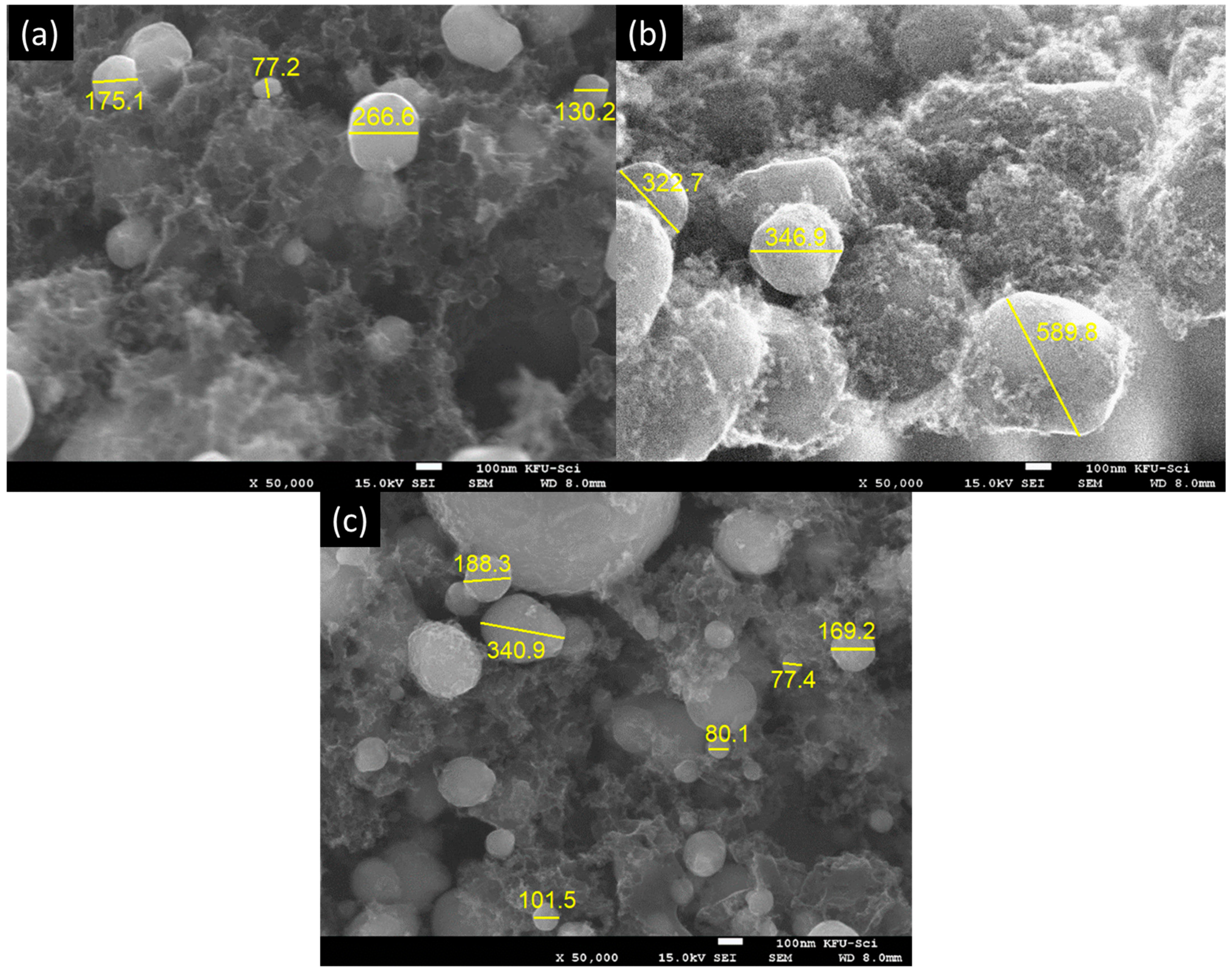
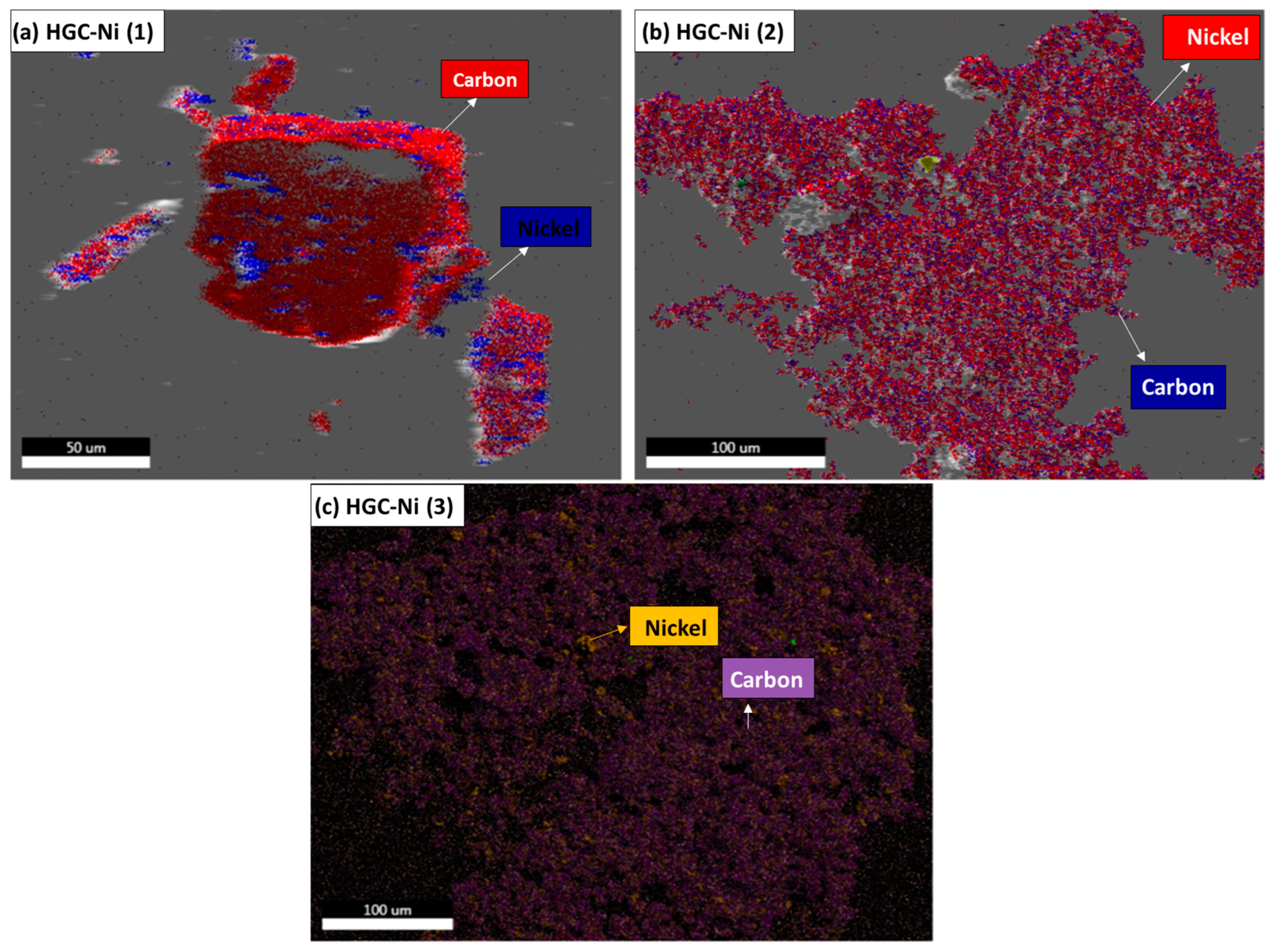


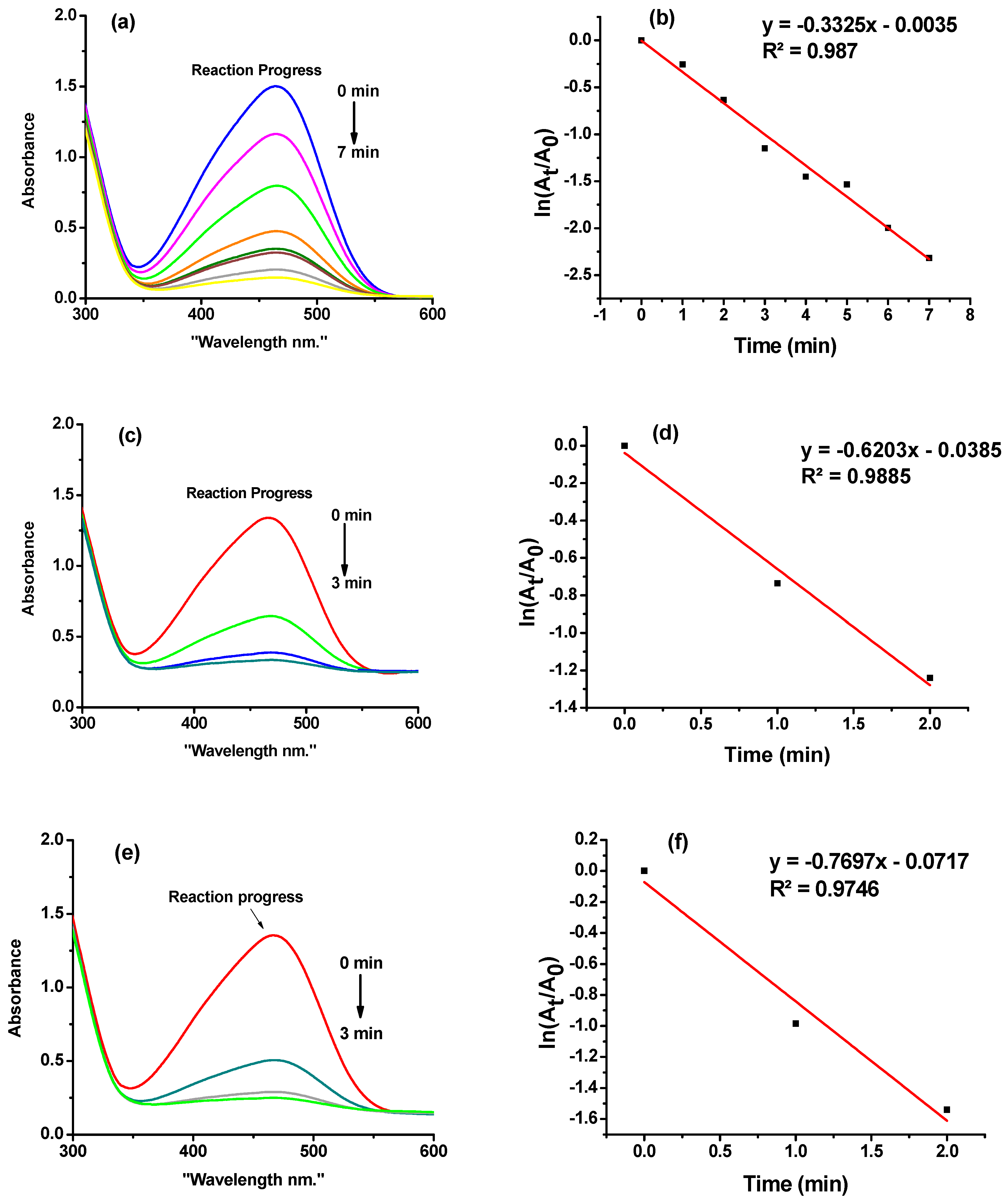
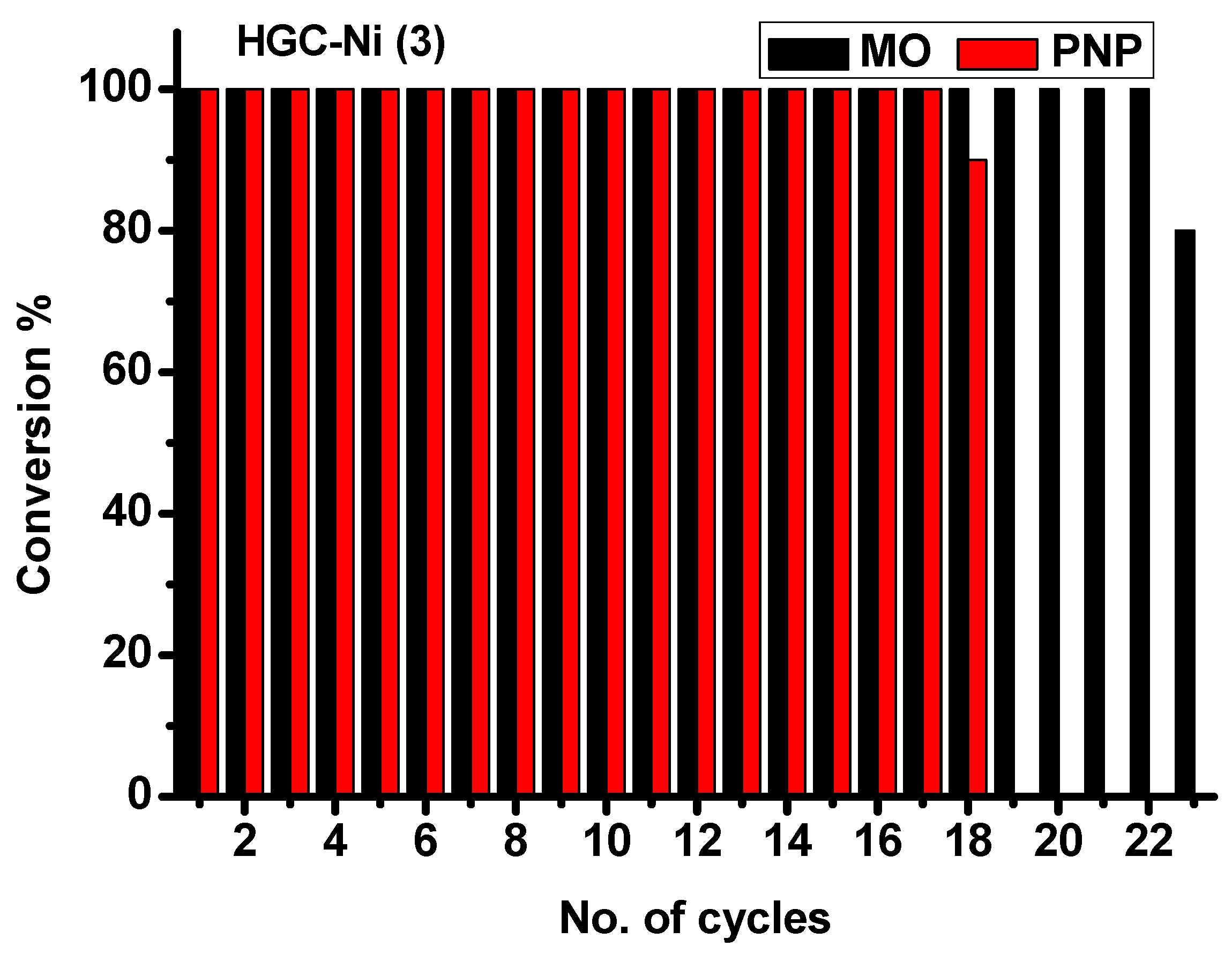
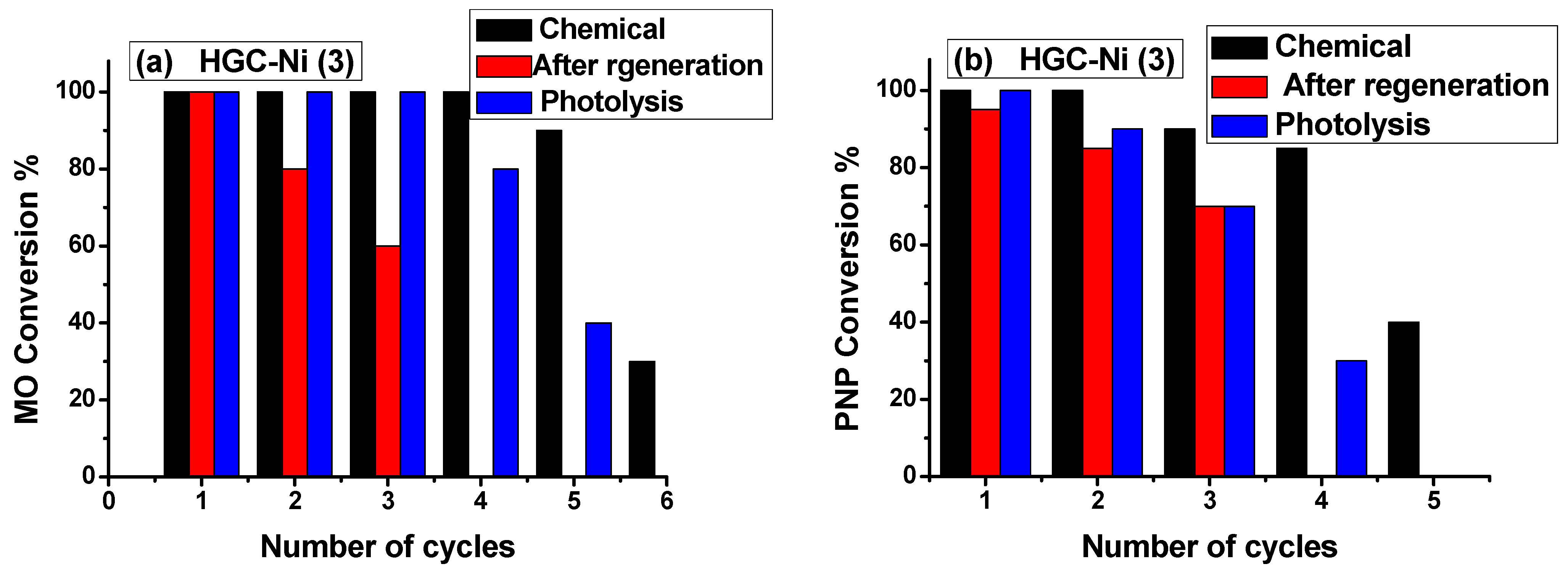


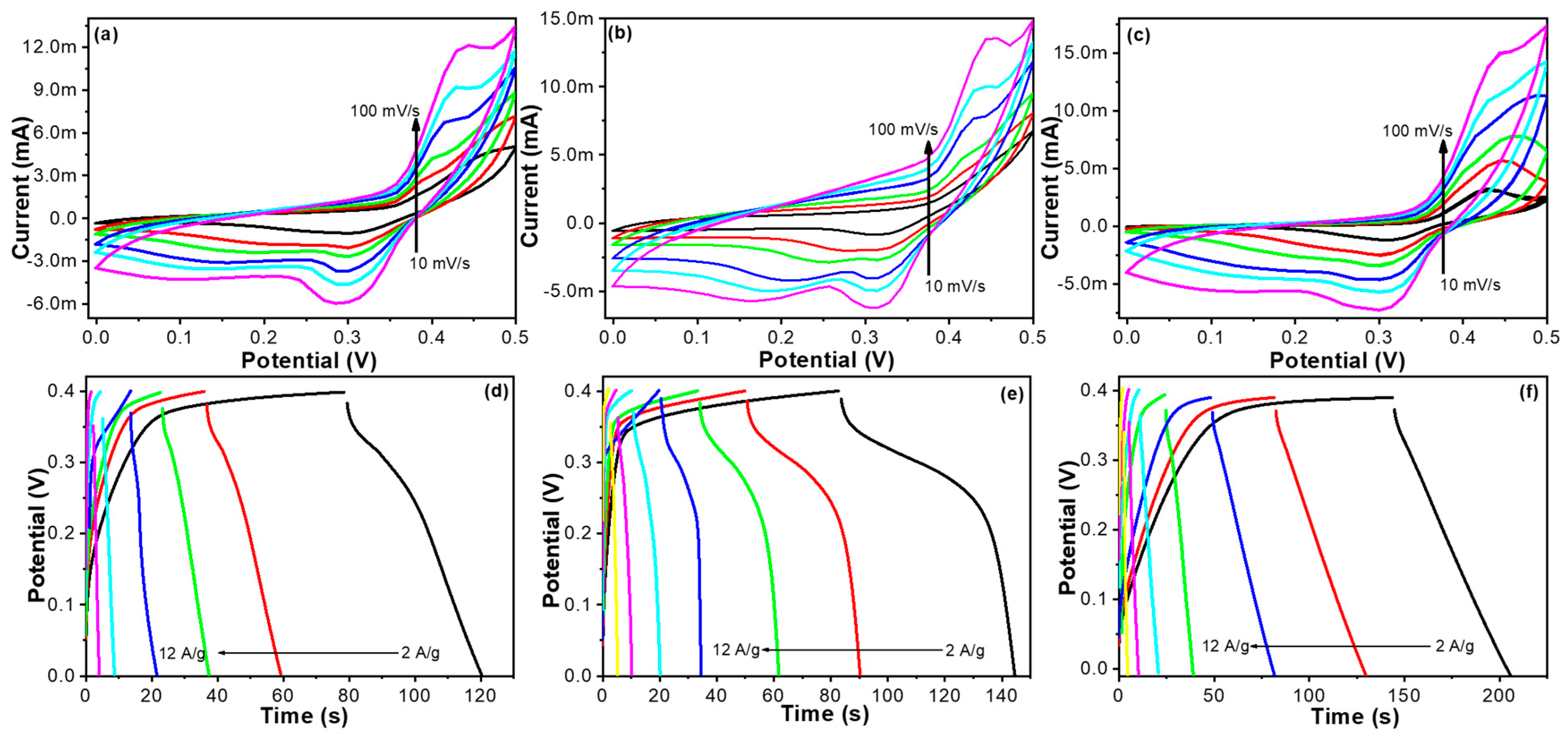


| Sample | PNP mL (mg) | No. of Cycles | Duration of All Cycles (min) | First-Order Rate Constant k min−1 (R2) | TON mg PNP/mg Nano (mmol PNP/mg Nano) | TOF mg PNP/mg Nano)/min (mmol PNP/mg Nano)/min) |
|---|---|---|---|---|---|---|
| HGC-Ni (1) | 0.8 (0.224) | 7.63 cycles | 109 min | 0.141 (0.97) | 1.0682 (0.0077) | 0.0098 (7.045 × 10−5) |
| HGC-Ni (2) | 0.5 (0.14) | 4.58 cycles | 68 min | 0.104 (0.871) | 0.6412 (0.0046) | 0.0094 (6.778 × 10−5) |
| HGC-Ni (3) | 1.8 (0.504) | 17.9 cycles | 325 min | 0.173 (0.98) | 2.4100 (0.017) | 0.0074 (5.33 × 10−5) |
| Sample | MO mL (mg) | No. of Cycles | Duration of All Cycles (min) | Rate Constant k min−1 (R2) | TON mg MO/mg Nano (mmol MO/mg nano) | TOF mg MO/mg Nano)/min (mmol MO/mg Nano)/min) |
|---|---|---|---|---|---|---|
| HGC-Ni (1) | 0.7 (0.896) | 13.9 cycles | 128 min | 0.404 (0.956) | 4.448 (0.0134) | 0.0347 (1.0616 × 10−4) |
| HGC-Ni (2) | 0.95 (1.23) | 18.8 cycles | 148 min | 0.365 (0.945) | 5.6928 (0.0174) | 0.0385 (1.175 × 10−4) |
| HGC-Ni (3) | 1.15 (1.47) | 22.8 cycles | 220 min | 0.363 (0.934) | 7.3024 (0.0223) | 0.0332 (1.014 × 10−4) |
Disclaimer/Publisher’s Note: The statements, opinions and data contained in all publications are solely those of the individual author(s) and contributor(s) and not of MDPI and/or the editor(s). MDPI and/or the editor(s) disclaim responsibility for any injury to people or property resulting from any ideas, methods, instructions or products referred to in the content. |
© 2024 by the authors. Licensee MDPI, Basel, Switzerland. This article is an open access article distributed under the terms and conditions of the Creative Commons Attribution (CC BY) license (https://creativecommons.org/licenses/by/4.0/).
Share and Cite
Hammud, H.H.; Aljamhi, W.A.; Al-Hudairi, D.E.; Parveen, N.; Ansari, S.A.; Prakasam, T. Catalytic and Capacitive Properties of Hierarchical Carbon–Nickel Nanocomposites. Catalysts 2024, 14, 181. https://doi.org/10.3390/catal14030181
Hammud HH, Aljamhi WA, Al-Hudairi DE, Parveen N, Ansari SA, Prakasam T. Catalytic and Capacitive Properties of Hierarchical Carbon–Nickel Nanocomposites. Catalysts. 2024; 14(3):181. https://doi.org/10.3390/catal14030181
Chicago/Turabian StyleHammud, Hassan H., Waleed A. Aljamhi, Dolayl E. Al-Hudairi, Nazish Parveen, Sajid Ali Ansari, and Thirumurugan Prakasam. 2024. "Catalytic and Capacitive Properties of Hierarchical Carbon–Nickel Nanocomposites" Catalysts 14, no. 3: 181. https://doi.org/10.3390/catal14030181
APA StyleHammud, H. H., Aljamhi, W. A., Al-Hudairi, D. E., Parveen, N., Ansari, S. A., & Prakasam, T. (2024). Catalytic and Capacitive Properties of Hierarchical Carbon–Nickel Nanocomposites. Catalysts, 14(3), 181. https://doi.org/10.3390/catal14030181







